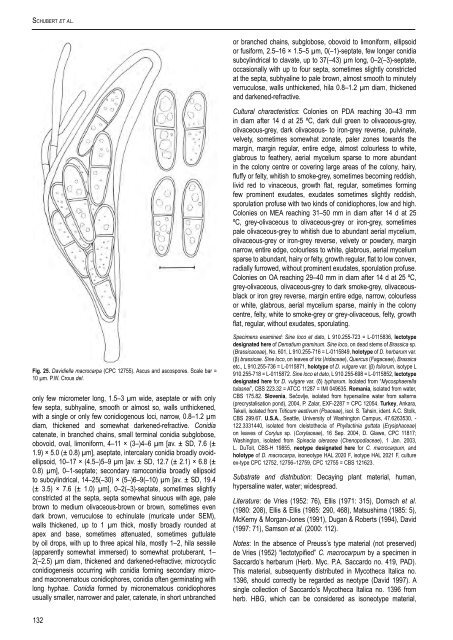The genus Cladosporium and similar dematiaceous ... - CBS - KNAW
The genus Cladosporium and similar dematiaceous ... - CBS - KNAW
The genus Cladosporium and similar dematiaceous ... - CBS - KNAW
You also want an ePaper? Increase the reach of your titles
YUMPU automatically turns print PDFs into web optimized ePapers that Google loves.
Schubert et al.<br />
or branched chains, subglobose, obovoid to limoniform, ellipsoid<br />
or fusiform, 2.5–16 × 1.5–5 µm, 0(–1)-septate, few longer conidia<br />
subcylindrical to clavate, up to 37(–43) µm long, 0–2(–3)-septate,<br />
occasionally with up to four septa, sometimes slightly constricted<br />
at the septa, subhyaline to pale brown, almost smooth to minutely<br />
verruculose, walls unthickened, hila 0.8–1.2 µm diam, thickened<br />
<strong>and</strong> darkened-refractive.<br />
Cultural characteristics: Colonies on PDA reaching 30–43 mm<br />
in diam after 14 d at 25 ºC, dark dull green to olivaceous-grey,<br />
olivaceous-grey, dark olivaceous- to iron-grey reverse, pulvinate,<br />
velvety, sometimes somewhat zonate, paler zones towards the<br />
margin, margin regular, entire edge, almost colourless to white,<br />
glabrous to feathery, aerial mycelium sparse to more abundant<br />
in the colony centre or covering large areas of the colony, hairy,<br />
fluffy or felty, whitish to smoke-grey, sometimes becoming reddish,<br />
livid red to vinaceous, growth flat, regular, sometimes forming<br />
few prominent exudates, exudates sometimes slightly reddish,<br />
sporulation profuse with two kinds of conidiophores, low <strong>and</strong> high.<br />
Colonies on MEA reaching 31–50 mm in diam after 14 d at 25<br />
ºC, grey-olivaceous to olivaceous-grey or iron-grey, sometimes<br />
pale olivaceous-grey to whitish due to abundant aerial mycelium,<br />
olivaceous-grey or iron-grey reverse, velvety or powdery, margin<br />
narrow, entire edge, colourless to white, glabrous, aerial mycelium<br />
sparse to abundant, hairy or felty, growth regular, flat to low convex,<br />
radially furrowed, without prominent exudates, sporulation profuse.<br />
Colonies on OA reaching 29–40 mm in diam after 14 d at 25 ºC,<br />
grey-olivaceous, olivaceous-grey to dark smoke-grey, olivaceousblack<br />
or iron grey reverse, margin entire edge, narrow, colourless<br />
or white, glabrous, aerial mycelium sparse, mainly in the colony<br />
centre, felty, white to smoke-grey or grey-olivaceous, felty, growth<br />
flat, regular, without exudates, sporulating.<br />
Fig. 25. Davidiella macrocarpa (CPC 12755). Ascus <strong>and</strong> ascospores. Scale bar =<br />
10 µm. P.W. Crous del.<br />
only few micrometer long, 1.5–3 µm wide, aseptate or with only<br />
few septa, subhyaline, smooth or almost so, walls unthickened,<br />
with a single or only few conidiogenous loci, narrow, 0.8–1.2 µm<br />
diam, thickened <strong>and</strong> somewhat darkened-refractive. Conidia<br />
catenate, in branched chains, small terminal conidia subglobose,<br />
obovoid, oval, limoniform, 4–11 × (3–)4–6 µm [av. ± SD, 7.6 (±<br />
1.9) × 5.0 (± 0.8) µm], aseptate, intercalary conidia broadly ovoidellipsoid,<br />
10–17 × (4.5–)5–9 µm [av. ± SD, 12.7 (± 2.1) × 6.8 (±<br />
0.8) µm], 0–1-septate; secondary ramoconidia broadly ellipsoid<br />
to subcylindrical, 14–25(–30) × (5–)6–9(–10) µm [av. ± SD, 19.4<br />
(± 3.5) × 7.6 (± 1.0) µm], 0–2(–3)-septate, sometimes slightly<br />
constricted at the septa, septa somewhat sinuous with age, pale<br />
brown to medium olivaceous-brown or brown, sometimes even<br />
dark brown, verruculose to echinulate (muricate under SEM),<br />
walls thickened, up to 1 µm thick, mostly broadly rounded at<br />
apex <strong>and</strong> base, sometimes attenuated, sometimes guttulate<br />
by oil drops, with up to three apical hila, mostly 1–2, hila sessile<br />
(apparently somewhat immersed) to somewhat protuberant, 1–<br />
2(–2.5) µm diam, thickened <strong>and</strong> darkened-refractive; microcyclic<br />
conidiogenesis occurring with conidia forming secondary micro<strong>and</strong><br />
macronematous conidiophores, conidia often germinating with<br />
long hyphae. Conidia formed by micronematous conidiophores<br />
usually smaller, narrower <strong>and</strong> paler, catenate, in short unbranched<br />
Specimens examined: Sine loco et dato, L 910.255-723 = L-0115836, lectotype<br />
designated here of Dematium graminum. Sine loco, on dead stems of Brassica sp.<br />
(Brassicaceae), No. 601, L 910.255-716 = L-0115849, holotype of D. herbarum var.<br />
(β) brassicae. Sine loco, on leaves of Iris (Iridaceae), Quercus (Fagaceae), Brassica<br />
etc., L 910.255-736 = L-0115871, holotype of D. vulgare var. (β) foliorum, isotype L<br />
910.255-718 = L-0115872. Sine loco et dato, L 910.255-698 = L-0115852, lectotype<br />
designated here for D. vulgare var. (δ) typharum. Isolated from “Mycosphaerella<br />
tulasnei”, <strong>CBS</strong> 223.32 = ATCC 11287 = IMI 049635. Romania, isolated from water,<br />
<strong>CBS</strong> 175.82. Slovenia, Sečovlje, isolated from hypersaline water from salterns<br />
(precrystalisation pond), 2004, P. Zalar, EXF-2287 = CPC 12054. Turkey, Ankara,<br />
Tekeli, isolated from Triticum aestivum (Poaceae), isol. S. Tahsin, ident. A.C. Stolk,<br />
<strong>CBS</strong> 299.67. U.S.A., Seattle, University of Washington Campus, 47.6263530, -<br />
122.3331440, isolated from cleistothecia of Phyllactinia guttata (Erysiphaceae)<br />
on leaves of Corylus sp. (Corylaceae), 16 Sep. 2004, D. Glawe, CPC 11817;<br />
Washington, isolated from Spinacia oleracea (Chenopodiaceae), 1 Jan. 2003,<br />
L. DuToit, <strong>CBS</strong>-H 19855, neotype designated here for C. macrocarpum, <strong>and</strong><br />
holotype of D. macrocarpa, isoneotype HAL 2020 F, isotype HAL 2021 F, culture<br />
ex-type CPC 12752, 12756–12759, CPC 12755 = <strong>CBS</strong> 121623.<br />
Substrate <strong>and</strong> distribution: Decaying plant material, human,<br />
hypersaline water, water; widespread.<br />
Literature: de Vries (1952: 76), Ellis (1971: 315), Domsch et al.<br />
(1980: 208), Ellis & Ellis (1985: 290, 468), Matsushima (1985: 5),<br />
McKemy & Morgan-Jones (1991), Dugan & Roberts (1994), David<br />
(1997: 71), Samson et al. (2000: 112).<br />
Notes: In the absence of Preuss’s type material (not preserved)<br />
de Vries (1952) “lectotypified” C. macrocarpum by a specimen in<br />
Saccardo’s herbarum (Herb. Myc. P.A. Saccardo no. 419, PAD).<br />
This material, subsequently distributed in Mycotheca Italica no.<br />
1396, should correctly be regarded as neotype (David 1997). A<br />
single collection of Saccardo’s Mycotheca Italica no. 1396 from<br />
herb. HBG, which can be considered as isoneotype material,<br />
132

















